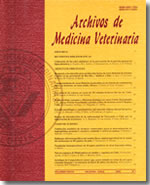Energy metabolism in shorn and unshorn pregnant ewes under two different nutritional planes. Effects on the energetic storage of their lambs
Main Article Content
Abstract
The aim of this work was to evaluate the role of nutrition and shearing during last third of pregnancy, on the energetic metabolism of ewes and the energetic storage of their lambs at parturition. 38 Corriedale ewes carrying single fetus were randomly divided in two groups at 90 days of pregnancy, R (n = 12, supplemented with ruminant concentrate) and CN (n = 26, fed on natural pastures). The energetic status of the ewes was evaluated using glicaemia and seric levels of ß-hidroxybutyrate. When reaching 110 days of gestation, half of the ewes in CN group were shorn (E). Newborn lambs were blooded to study glicaemia levels at parturition and 24 h afterwards, weighed at birth and after 24, 48 and 72 h, and total weight and energetic value of their perirenal brown fat was measured. Ewes in groups R and E presented glicaemia levels higher than those in CN in the days before at parturition, whereas hydroxybutyrate was more elevated in groups CN and E than in group R. The weight of ewe-lambs at birth did not differ between groups, but by this time glicaemia levels were higher in group R than in CN. Glicaemia was also higher in lambs of both groups R and E by 24 h after birth. Perirenal brown fat in group E had highter caloric value compared to CN, which suggests a relationship between the energetic status and management of ewes at parturition and the energetic storage of their lambs at birth.

